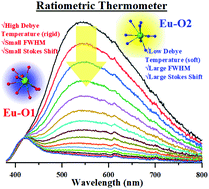Regulation of double luminescence centers based on the evolution of disordered local structure for ratiometric temperature sensing applications†
Abstract
Non-contact temperature sensors have important application prospects in the optoelectronic field, and their highly sensitive response to wide-range temperature changes is an important development direction. Herein, we propose an Eu2+-activated Sr3−xLa1+xP3−xSixO12 phosphor which shows an outstanding ratiometric temperature sensing performance over a super broad temperature range from 303 to 533 K (a relative sensitivity Sr of ≥1% K−1 and a repeatability capability of over 99%). The structural and luminescence investigations reveal an uncommon phenomenon, i.e. Eu2+ ions were located at a single crystallographic site but produced two emission bands due to the disordering of O1 and O2. As confirmed by the theoretical Debye temperature, the rigid and soft local structures of O1 and O2 coordinated to Eu2+ lead to the thermally stable purple and thermally sensitive yellow emission bands, respectively. Our findings offer useful inspiration for investigating high-performance luminescent thermometers and understanding the structure–property relationships in materials science.



 Please wait while we load your content...
Please wait while we load your content...